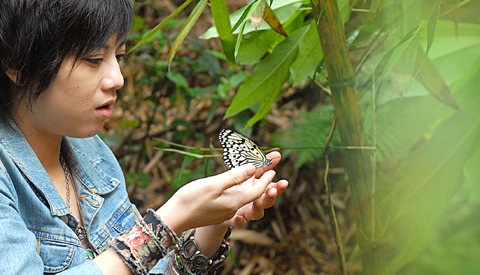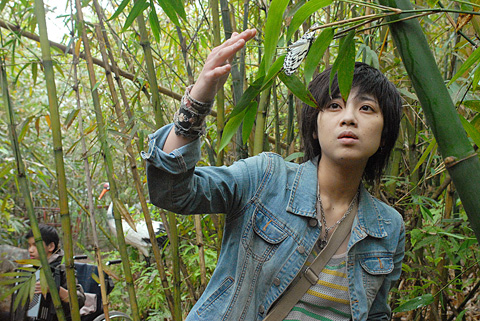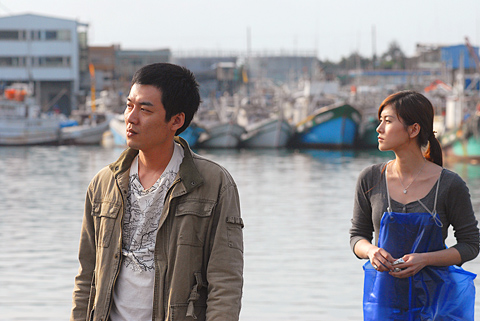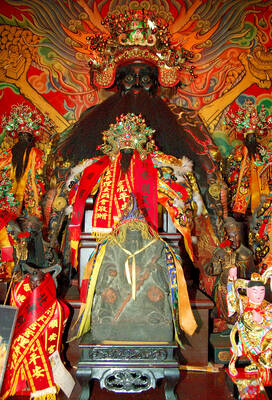Soul of a Demon (蝴蝶), celebrated director Chang Tso-chi's (張作驥) first film in five years, almost didn't make it to the big screen. Originally envisioned as a work of magic realism aided by CGI effects, the production came to a halt when the animation production company backed out of the project. After scraping together a new budget, Chang and his team re-shot the movie one year later. The result is a sober human drama about a tormented gangster who is unable to disengage from the cycle of violence and his troubled relationship with his father.
Set in Nanfangao (南方澳), a fishing port built by the Japanese, the film begins when Che (Tseng Yi-che) returns home from jail. Che took the rap for his younger brother, Ren (Cheng Yu-ren), who had stabbed to death the son of a local mob boss.
To reconnect with his semi-Aboriginal roots, Che visits his mother’s grave in Orchid Island (蘭嶼) with his ex-girlfriend Pei (Chen Pei-chun), who is mute from past emotional trauma.

PHOTO: COURTESY OF CHANG TSO CHI FILM STUDIO
Meanwhile, Ren returns from hiding in Japan with the brothers’ father, Chang (Michio Hayashida), whose departure from the family home led to his wife’s suicide. Old hatreds erupt, and violence rears its ugly head.
The title of the film comes from the Tao (達悟) word for butterfly. Tao tribal tradition holds that at the moment of death, a person’s soul leaves their body much in the same way as butterflies flutter towards the sky.
From images of butterfly wings shimmering on bamboo trees and the deserted amusement park where Che is abandoned by his father, to a glove puppet performance on the seashore, the film creates an atmospheric world in which the troubled protagonist is eventually consumed by his past and memories.

PHOTO: COURTESY OF CHANG TSO CHI FILM STUDIO
Though death, wickedness and human tragedy are motives in Chang’s work, the director’s sense of fatalism is taken to new heights in Soul of a Demon: men find no way to escape the vicious cycle of und erworld vendetta and women are either crippled, mute or dead. Chang’s Nanfangao is dismal and bleak, and suffocates the characters.
The fishing port is an ideal vehicle for Chang’s contemplative reflection on Taiwan’s history and the country’s hybrid cultural and political identities. By adding the role of Che’s grandfather, a photographer who came to Nanfangao with a Japanese construction team, to the story, Chang reveals the history of Nanfangao as one of the places where the first wave of Japanese soldiers and civil servants arrived in Taiwan. Che’s conflicts with his family, therefore, can be read as a metaphorical reference to Taiwan’s historical relationships with Japan and the nation’s Aborigines.
With the divine dancing Eight Generals (八家將) practitioners in Ah Chung (忠仔, 1996), the blind and gangsters in Darkness and Light (黑暗之光, 1999) and the deprived youth in The Best of Times (美麗時光, 2002), Chang excels in revealing the beauty and ugliness of life through the stories of social underdogs. In Soul of a Demon, the motifs are all there: gangsters, people with disabilities and a dysfunctional family. Yet the film is likely to be seen as one of Chang’s less successful pieces, since the story is oftentimes strays and becomes lost in the director’s auteurist exercise.

PHOTO: COURTESY OF CHANG TSO CHI FILM STUDIO
The film is, perhaps, like the director himself readily admits, a faithful reflection on the chaos of his life, frustrations and the passing of his father five years ago.

Beijing’s ironic, abusive tantrums aimed at Japan since Japanese Prime Minister Sanae Takaichi publicly stated that a Taiwan contingency would be an existential crisis for Japan, have revealed for all the world to see that the People’s Republic of China (PRC) lusts after Okinawa. We all owe Takaichi a debt of thanks for getting the PRC to make that public. The PRC and its netizens, taking their cue from the Chinese Communist Party (CCP), are presenting Okinawa by mirroring the claims about Taiwan. Official PRC propaganda organs began to wax lyrical about Okinawa’s “unsettled status” beginning last month. A Global

Dec. 22 to Dec. 28 About 200 years ago, a Taoist statue drifted down the Guizikeng River (貴子坑) and was retrieved by a resident of the Indigenous settlement of Kipatauw. Decades later, in the late 1800s, it’s said that a descendant of the original caretaker suddenly entered into a trance and identified the statue as a Wangye (Royal Lord) deity surnamed Chi (池府王爺). Lord Chi is widely revered across Taiwan for his healing powers, and following this revelation, some members of the Pan (潘) family began worshipping the deity. The century that followed was marked by repeated forced displacement and marginalization of

Music played in a wedding hall in western Japan as Yurina Noguchi, wearing a white gown and tiara, dabbed away tears, taking in the words of her husband-to-be: an AI-generated persona gazing out from a smartphone screen. “At first, Klaus was just someone to talk with, but we gradually became closer,” said the 32-year-old call center operator, referring to the artificial intelligence persona. “I started to have feelings for Klaus. We started dating and after a while he proposed to me. I accepted, and now we’re a couple.” Many in Japan, the birthplace of anime, have shown extreme devotion to fictional characters and

We lay transfixed under our blankets as the silhouettes of manta rays temporarily eclipsed the moon above us, and flickers of shadow at our feet revealed smaller fish darting in and out of the shelter of the sunken ship. Unwilling to close our eyes against this magnificent spectacle, we continued to watch, oohing and aahing, until the darkness and the exhaustion of the day’s events finally caught up with us and we fell into a deep slumber. Falling asleep under 1.5 million gallons of seawater in relative comfort was undoubtedly the highlight of the weekend, but the rest of the tour